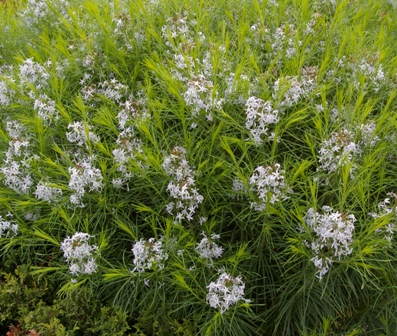Recently, I was asked to design a border for a narrow bed fronting the largest solar power array in the State of Oregon. The array is situated in the interior of the Baldock Rest Stop just north of Aurora on I-5 going north. The site is four hundred feet long and four feet wide and is surrounded by fencing on all sides. In addition, the site has no ready access to water. All of the plants selected must be drought tolerant. As I began to envision this unusual site, one of the first shrubs that came to mind was Cistus.
We have long been familiar with a number of species and cultivars of Cistus at Joy Creek Nursery. In 2005, however, we were very pleased to learn that Oregon State University was trialing a large collection of Cistus and the allied genus Halimium at the North Willamette Research and Extension Center near Aurora, Oregon. This gave us the opportunity to observe new and unfamiliar plants all in one place. Both of these genera are native to the Mediterranean areas of Europe and North Africa and have long been used in gardens in parts of California with an allied climate. They have been much less common in Northwest gardens.
In 2006, the Research Center offered to share cuttings with our nursery. Of course, we were thrilled. This began our own trials of Cistus and Halimium in what we call our no-water border. Our trials involved not only cold hardiness, but also drought tolerance.
The winter of 2009 was one of the cruelest in recent memory. At the nursery, cold temperatures plummeted to just above 10°F in mid-December and snow fell most of the last two weeks of that month. The effect of sudden cold after a mild autumn was bad enough, but the accumulation of snow also did great damage, breaking off branches and even snapping entire plants off at their crowns. It became obvious to us that the weight of wet snow is a problem for many of the evergreen Cistus.
In the spring we counted the true survivors of our trials. These were shrubs that showed no signs of winter damage. We were surprised. Only ten of the 30 varieties we had planted were unharmed. An additional seven were only slightly damaged and the balance were killed or never fully recovered. We replanted and trialed again only to have another severely cold, exceptionally long, dark and wet winter. This time, most of the plants survived although many were hurt when temperatures dipped to 9°F. The following is a list of the nine that best withstood those two winters.
Cistus ‘Anne Palmer’
Cistus x argenteus ‘Paper Moon’
Cistus x argenteus ‘Stripey’
Cistus ‘Elma’
Cistus ‘Jessamy Beauty’
Cistus x ledon
Cistus x platysepala
Halimium lasianthum ‘Sanderling’
Halimium x pauanum
As my vision of the bed at the Baldock site began to develop, I was certain that I wanted to use Citus and Halimiums because their silver and grey foliage would suggest the reflective power of the solar array behind them. Further, I also wanted to include shrubs with yellow flowers to suggest the sun. Because Halimium x pauanum has yellow flowers, it became one of my theme plants.
During one of my visits to the site, I realized that it was situated only a mile or so from the Willamette Research Station where we had received many of our plants. And so the design also pays homage to the trials that took place just down the road.
The garden was sponsored by Portland General Electric, Oregon Department of Transportation and the Master Gardeners of Oregon™. It will be planted on March 24th, 2012 with assistance from volunteer Master Gardeners.
Maurice Horn










